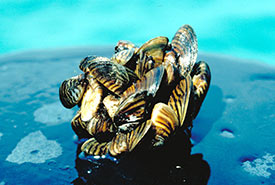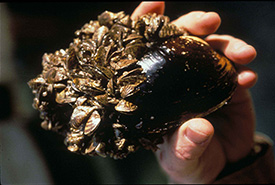Something's Fishy: A razor-sharp invader

Zebra mussel (Photo by U.S. Environmental Protection Agency)
My first encounter with zebra mussels is an experience many Canadians can relate to. It started with searing pain, a yelp and a quick hobble out of the water and up onto a rocky shoreline to examine the bottom of my foot, sliced open ever so slightly.
The culprit of this attack is responsible for more damage than just the cut on my foot. Zebra mussels are an invasive species that has spread from its native Black Sea region of eastern Europe and western Asia waters to Canada. They can be found throughout all of the Great Lakes, Lake St. Clair (in between Michigan and Ontario) and the Mississippi River watershed. This pesky species was first observed in 1988 in Ontario, and they have now made their way into Lake Winnipeg.

Zebra mussels (Photo by U.S. Fish and Wildlife Service)
Zebra mussels are freshwater mussels measuring around 2.5 centimetres long, but can grow up to four centimetres. They are named for the dark, striped pattern on their sharp shell, and they are wreaking havoc on Canadian lakes.
They are highly adaptable and can survive in a variety of water temperatures and conditions. A single female zebra mussel can produce up to a million eggs per year. As the eggs are free floating, they are picked up by water currents, wind and waves and can quickly spread in large numbers through the water. A few weeks later after the eggs are released and as the larvae develop, they secrete sticky fibres to attach themselves to any hard surface within the water.
Zebra mussels negatively impact habitats by filtering watering, which removes plankton from the water. A single zebra mussel can filter up to one litre of water a day. Plankton is the foundation of many food chains, including those of native fish and wildlife. As a result, the decreased levels of plankton in the water upset the balance of food chains in ecosystems. Also, clearer water as a result of filtering allows sunlight to easily penetrate and warm up the water. This increases aquatic vegetation and algal growth.
In addition to their sharp shells being hazardous for swimmers and beachgoers, they pose potential health impacts to the seafood we consume.
The contaminants that zebra mussels consume through filtering water can move up the food chain if the affected mussel is consumed by a fish that is consumed by, let’s say, a larger fish. That larger fish could then be consumed by a human.
Zebra mussels can also impact infrastructure, such as blocking pipes and damaging docks and boats. In fact, it is believed that they were first spread through ballast water in European transport ships and then through Canadian waters during recreational activities.
Similar in appearance to zebra mussels, non-native quagga mussels are also invading Canadian waters. First found in Lake Ontario in 1989, quagga mussels have similar impacts as zebra mussels, but can occupy deeper waters. Over the last 20 years, they have largely replaced zebra mussels in much of the Great Lakes.
To avoid the spread of either species, people should take precautions. Boaters should inspect their aquatic equipment for zebra or quagga mussels and wash the equipment down before using it in another body of water. Zebra or quagga mussel sightings in Ontario can be reported to the Invading Species Awareness Program.
Stopping the spread of invasive species like zebra mussels helps native species flourish and landscapes thrive. It also keeps feet safe!


